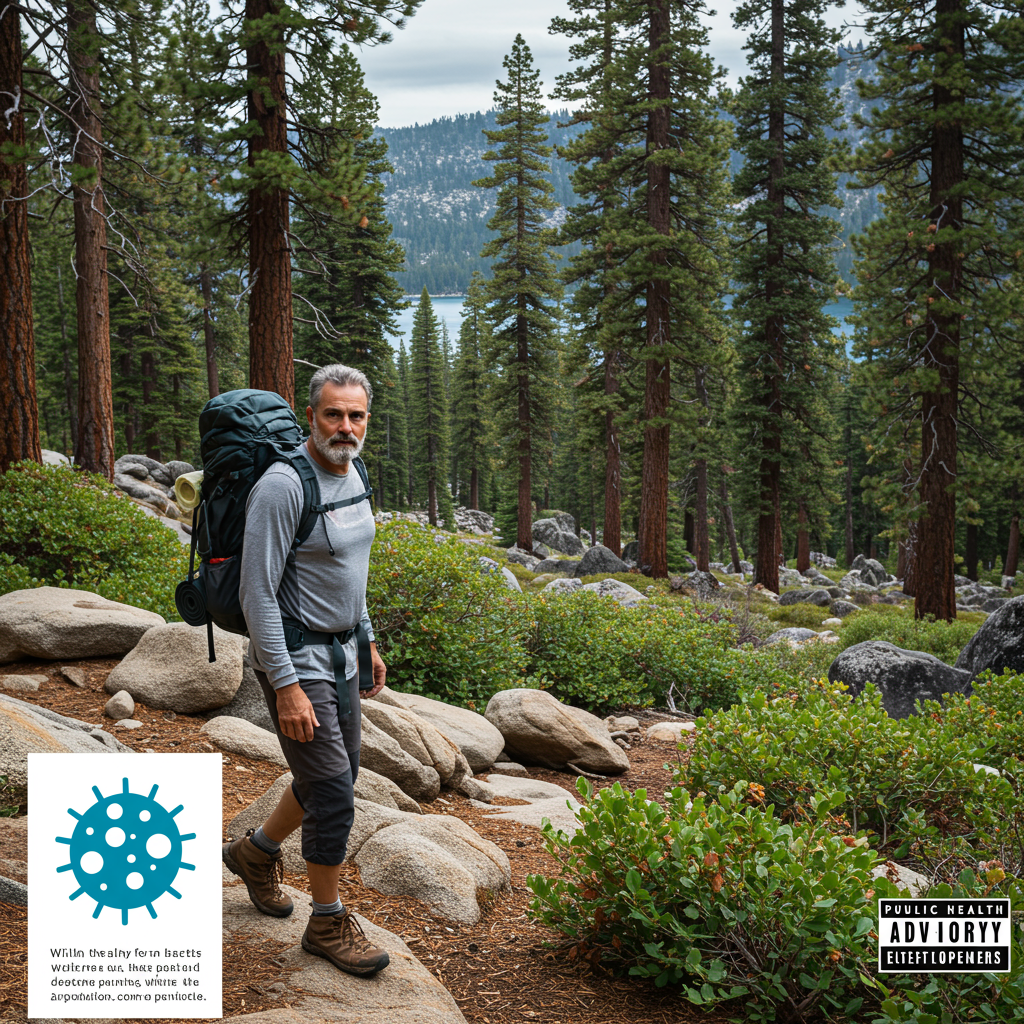A recent California plague case has emerged in South Lake Tahoe, prompting local health officials to issue public health advisories. This rare but serious bacterial infection, confirmed in a resident believed to have contracted it while camping, highlights the ongoing natural presence of plague in certain parts of California. While human cases are uncommon, understanding how plague spreads and what preventive measures to take is crucial for outdoor enthusiasts and their pets. This comprehensive guide details the recent incident, explains the disease, outlines symptoms, and provides essential prevention tips to keep you and your loved ones safe.
The Recent California Plague Case: What Happened?
In a significant development for public health in the region, health authorities in El Dorado County recently confirmed that a South Lake Tahoe resident tested positive for the plague. The individual, whose identity has not been released, is currently recovering at home under professional medical care, indicating a positive prognosis due to early detection and treatment. Officials suspect the infection likely resulted from a flea bite acquired during a camping trip within the popular recreational areas surrounding South Lake Tahoe.
This incident, announced on Thursday, August 21, 2025, by local health officials, follows notification from the California Department of Public Health (CDPH). An investigation into the precise circumstances of the infection is actively underway. The case serves as a timely reminder that the bacterium responsible for plague is naturally present in wildlife populations across many higher-elevation areas of California, including sections of El Dorado County.
South Lake Tahoe: A Known Risk Area
The South Lake Tahoe area is not unfamiliar with the presence of plague. El Dorado County’s acting director of public health, Kyle Fliflet, reiterated that plague is naturally endemic to many regions of California, particularly in mountainous and higher-elevation locales. This echoes previous incidents; the last confirmed human case in El Dorado County occurred in 2020, also believed to be linked to the South Lake Tahoe vicinity. Furthermore, in 2021, the US Forest Service temporarily closed several popular Lake Tahoe sites after plague was detected in local chipmunk populations, leading to extensive vector control measures.
Understanding Plague: The Science Behind the Threat
Plague is a serious infectious disease caused by the bacterium Yersinia pestis. While its name conjures historical images, modern plague is far from the uncontrolled epidemics of the past due to advancements in medical science and public health. Nevertheless, awareness remains key.
How Plague Spreads: Fleas and Rodents
The most common way humans contract plague is through the bites of infected fleas. These fleas acquire the Yersinia pestis bacteria from small wild mammals, primarily rodents like squirrels, chipmunks, voles, mice, and prairie dogs. When an infected flea bites a human, the bacteria can be transmitted, leading to illness.
It’s also crucial to understand that domestic animals, especially dogs and cats, can inadvertently play a role in transmission. These pets can pick up infected fleas from wildlife while exploring outdoors and bring them into homes, inadvertently exposing their human companions. Additionally, humans can contract plague by directly handling an infected animal, though this is less common.
Types of Plague: Recognizing the Forms
While most cases are bubonic, there are three main forms of plague, each with distinct characteristics and varying degrees of severity:
Bubonic Plague: This is the most common form, characterized by the development of swollen, tender, and painful lymph nodes called “buboes.” These typically appear in the groin, armpit, or neck areas, often close to the site of the original flea bite. Other symptoms include sudden onset of fever, chills, headache, and extreme weakness.
Septicemic Plague: This form occurs when the Yersinia pestis bacteria multiply in the bloodstream. It can occur on its own or develop from untreated bubonic plague. Symptoms include fever, chills, extreme weakness, abdominal pain, shock, and potentially bleeding into the skin and other organs. Buboes are generally not present in this form.
Pneumonic Plague: The most serious and rarest form, pneumonic plague affects the lungs. It can develop from bubonic or septicemic plague if the infection spreads to the lungs, or it can be contracted directly through inhaling infectious droplets from an infected person or animal (e.g., a cat with pneumonic plague). Symptoms include fever, headache, weakness, rapidly developing pneumonia with shortness of breath, chest pain, and a cough often with bloody sputum. This form is particularly concerning because it can spread person-to-person through airborne droplets.
Symptoms and Treatment: Recognizing the Warning Signs
Knowing the symptoms of plague is vital for early detection, which is critical for effective treatment and a positive outcome.
Key Symptoms to Watch For
If exposed to the plague bacterium, symptoms typically appear within two weeks, though sometimes as early as a few days. Common indicators across different forms of plague include:
Sudden high fever and chills
Headache
General weakness and extreme tiredness
Nausea and vomiting
Muscle aches
For bubonic plague, the hallmark symptom is the appearance of swollen lymph nodes (buboes). These can range in size and are often painful to the touch. Should you experience any of these symptoms, particularly after being in an area known to have plague activity or having potential exposure to wild rodents or fleas, seek medical attention immediately.
Effective Treatment and High Survival Rates
The good news is that if detected early, plague is highly treatable with common antibiotics. Dr. Melanie Ott, director of the Gladstone Institute and Professor at UCSF, emphasizes that “wonderful medicines applied antibiotics” are very effective. The prompt administration of antibiotics is crucial to prevent the disease from progressing to more severe forms like septicemic or pneumonic plague, which carry higher mortality rates.
With timely and appropriate treatment, the survival rate for plague in the U.S. is remarkably high, often exceeding 90%. This starkly contrasts with historical periods when plague devastated populations before the advent of antibiotics. Patients diagnosed with pneumonic plague may be isolated during treatment to prevent further spread, and caregivers will use protective gear. There is currently no vaccine for plague, but post-exposure antibiotics can prevent infection.
Plague in California: A Natural but Rare Occurrence
Despite the alarming name, human cases of plague in the United States are exceptionally rare. The Centers for Disease Control and Prevention (CDC) estimates an average of only seven human plague cases per year nationally. The vast majority of these cases occur in the western U.S., specifically in rural areas of northern New Mexico, northern Arizona, southern Colorado, California, southern Oregon, and far western Nevada.
Ongoing Surveillance and Past Incidents
The California Department of Public Health (CDPH) actively monitors rodent populations throughout the state for evidence of plague activity. This robust surveillance program is essential for tracking the disease’s presence in wildlife and providing early warnings to communities. For example, surveillance efforts in El Dorado County from 2021 through 2024 identified 41 rodents that showed signs of exposure to the plague bacterium. So far in 2025, four rodents have tested positive, all within the Tahoe Basin.
Beyond the recent South Lake Tahoe case and the 2020 incident in the same area, California has seen other human cases. In 2015, two individuals reportedly contracted plague after exposure in Yosemite National Park. All previously identified individuals were successfully treated and recovered. Nationally, the threat remains; a human case was detected in Colorado in July 2024, and tragically, a resident of northern Arizona died from pneumonic plague in July 2024, marking the first recorded death from this form of the disease in the U.S. since 2007.
Essential Prevention Strategies for Outdoor Enthusiasts
Given plague’s natural presence in California’s wild areas, particularly in higher elevations, taking sensible precautions is paramount for anyone spending time outdoors. These measures significantly reduce the risk of exposure for both humans and pets.
Protecting Yourself in the Wilderness
When walking, hiking, or camping in areas where wild rodents are present, especially in endemic zones like the Tahoe Basin, consider these vital steps:
Avoid Contact with Wild Rodents: Never feed, touch, or handle wild rodents like squirrels, chipmunks, or other small mammals. This includes live, sick, or dead animals. If you encounter a dead rodent, do not touch it.
Prevent Flea Bites: Wear long pants tucked into your boots or socks to minimize exposed skin, especially around your ankles and lower legs. Consider applying insect repellent containing DEET to your socks and pant cuffs.
Choose Camp Sites Wisely: Avoid setting up tents, sleeping, or resting near animal burrows or areas where dead rodents have been observed. Pay attention to any posted warning signs in recreational areas.
Report Sick or Dead Animals: If you observe unusually sick or dead rodents, notify park rangers or local health officials.
Safeguarding Your Pets
Pets, particularly dogs and cats, can unwittingly bring infected fleas into your home, posing a risk to your family.
Flea Control: Consult your veterinarian about appropriate flea control products for your pets, especially if they spend time outdoors in areas where plague is endemic. Regular flea prevention is crucial.
Monitor Pet Behavior: Prevent your pets from playing with, picking up, or going near wild rodents or their burrows. If your pet falls ill with a sudden fever, lethargy, or swollen lymph nodes after outdoor activity, seek veterinary care immediately and inform your vet about potential rodent exposure.
Check for Fleas: Regularly check your pets for fleas, especially after walks or outdoor excursions.
Dispelling Myths: Why Modern Plague Isn’t the Black Death
The word “plague” often evokes images of the devastating Black Death that swept through Europe in the Middle Ages, claiming an estimated 25 million lives. However, it’s crucial to understand that modern plague is a vastly different threat.
Historical Context vs. Present Reality
While the Yersinia pestis bacterium is the same, our understanding and ability to combat the disease have evolved dramatically. Dr. Peter Chin-Hong, an infectious disease expert at UCSF, notes that the near disappearance of widespread plague epidemics is largely due to improved sanitation and a significant reduction in rat populations in urban environments, which limits the bacteria’s ability to thrive and spread.
Today, thanks to effective antibiotics and robust public health surveillance systems, human plague cases are rare and highly treatable. The focus has shifted from containing an unstoppable pandemic to localized prevention and rapid response, as demonstrated by the swift action taken in El Dorado County. Public awareness about safe practices in outdoor settings, rather than widespread panic, is the appropriate response to the ongoing, albeit limited, presence of plague in natural environments.
Frequently Asked Questions
What is plague and how is it transmitted?
Plague is a serious infectious disease caused by the bacterium Yersinia pestis*. It is primarily transmitted to humans through the bites of fleas that have previously fed on infected wild rodents such as squirrels, chipmunks, and other small mammals. Less commonly, it can also spread through direct contact with infected animal tissue, or in rare cases of pneumonic plague, through airborne droplets from an infected person or animal. The disease is naturally present in many parts of California, particularly in higher-elevation areas.
Where in California is plague most commonly found?
Plague is naturally endemic to many higher-elevation and mountainous regions of California, including parts of El Dorado County and the Tahoe Basin, where the recent case occurred. Other areas with known plague activity include Yosemite National Park. The California Department of Public Health (CDPH) actively monitors rodent populations across the state, with surveillance efforts in El Dorado County consistently identifying plague-exposed rodents in recent years, including four cases in the Tahoe Basin in 2025 alone.
What steps should I take to prevent plague when camping in California?
To prevent plague while camping or engaging in outdoor activities in California’s wilderness, it’s essential to avoid contact with wild rodents and their fleas. Never feed or handle wild animals, especially if they appear sick or dead. When camping, avoid setting up near rodent burrows and wear long pants tucked into boots or socks. Using insect repellent containing DEET on clothing can also help deter fleas. Ensure pets are on flea control and prevent them from interacting with wild rodents, as they can bring infected fleas into your home.
Conclusion
The recent California plague case in South Lake Tahoe serves as a powerful reminder of the importance of awareness and preparedness when enjoying the state’s natural beauty. While human plague infections are remarkably rare and effectively treatable with antibiotics, understanding the risks and implementing simple preventive measures is crucial. By taking precautions to avoid contact with wild rodents and their fleas, especially in known endemic areas, outdoor enthusiasts can significantly reduce their risk. If you suspect exposure or experience symptoms after being in a high-risk area, prompt medical attention is vital for a full recovery. Stay informed, stay vigilant, and continue to enjoy California’s stunning wilderness safely.




